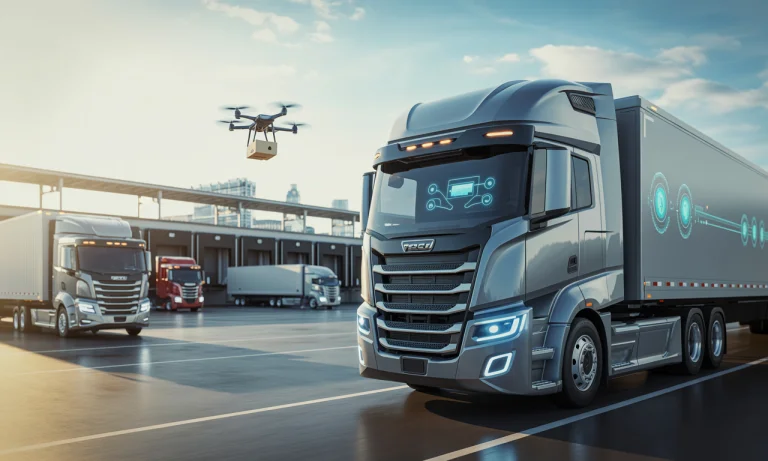Across the sprawling highways and humming distribution centers of today’s world, the trucking industry is rewriting its own story. Once reliant on human stamina and mechanical grit, freight transport is now shaped by the hands of code and algorithms as much as steel and diesel. Fleets large and small are caught in this changing current: technologies like artificial intelligence, automation, and next-generation truck models from titans such as Tesla, Waymo, Daimler Trucks, and Volvo Trucks are not just buzzwords—they are redefining the rules of the game. Efficiency, safety, and environmental responsibility collide with age-old business practices and human concerns. Companies either ride the wave of innovation or risk being left behind, and drivers face new challenges alongside new tools. As stories from the road crisscross with data from logistics hubs, the question at the heart of the industry is simple: How will these advancements change the rhythm of everyday freight and the lives it moves?
AI and Automation: Pioneers of Modern Trucking Transformation
On a brisk morning outside Madison, Wisconsin, Mike Nichols waits for his agricultural load with unusual patience. Unlike many of America’s 2.2 million drivers, Nichols is spared long hours of idle detention, a headache that still plagues countless colleagues who haul consumer goods for giants like Amazon or regional grocers. This efficiency is no accident—it’s the result of targeted technology adoption at savvy warehouses and carriers. Across the country, Advanced Driver Assistance Systems (ADAS) have moved from luxury add-ons to essentials. These AI-driven upgrades, including automatic braking, lane-centering, and adaptive cruise control systems, are the new co-pilots keeping drivers like Nichols safe on the road.
| Technology | Main Benefit | Key Companies |
|---|---|---|
| ADAS (Advanced Driver Assistance Systems) | Reduces accidents and driver fatigue | Tesla, Daimler Trucks, Volvo Trucks |
| AI-Optimized Routing | Improves delivery and operational efficiency | Waymo, Plus.ai, Embark |
| Autonomous Navigation | Enables driverless freight transport | Waymo, TuSimple, PACCAR |
From Manual Wait Times to Tech-Powered Logistics Efficiency
For years, detention time—drivers stuck waiting for their trucks to be loaded or unloaded—ate up billions in lost wages and even worsened road safety. FreightWaves calculated 119 minutes of average wait per delivery, while a US Department of Transportation study quantified nearly $1.1 billion lost annually due to these inefficiencies. Now, AI-enabled logistics platforms analyze not just traffic and weather but also live warehouse capacity, aiming to slash these costly waits. Systems by Embark and TuSimple help fleet managers plan when and where each truck will arrive, maximizing turnover.
With the help of dynamic routing algorithms, informed by real-time data, modern carriers can boost driver satisfaction, reduce accident rates, and ultimately deliver better service to clients. Warehouses themselves aren’t left out; smart automation streamlines inventory handling and ensures just-in-time loading. Yet, the human side remains: retaining skilled workers and keeping morale high amidst these sweeping changes presents a new set of challenges.
Autonomous and Electric Trucks: Realities Shaping 2025’s Freight Flow
Out on the I-40, autonomous trucks are now more than distant prototypes—they’re a daily sight on major routes. Vehicles by Tesla, Waymo, and Volvo Trucks are equipped with AI-guided radar, LiDAR, and camera systems, reshaping the logistics landscape. Navio L5, for instance, bids farewell to the driver’s seat entirely, guided by digital eyes instead of human ones. These machines whisper a promise: a potential end to labor shortages, safer night driving, and seamless coast-to-coast hauls.
| Company | Innovation | Impact |
|---|---|---|
| Waymo | Fully autonomous Class 8 trucks | Reduces driver workload and increases safety |
| Plus.ai | AI-based driver support for mixed fleets | Optimizes fuel use and mitigates fatigue |
| Nikola Motor | Hydrogen-powered semi-trucks | Mitigates emissions for long-haul transport |
| Einride | Cabless, electric pod trucks | Reduces labor costs and localizes emissions |
Sustainability and the Push for Greener Transport
The environmental footprint of trucking, long dominated by diesel, is being radically updated. Innovators like Nikola Motor and Einride are carving new lanes with hydrogen and electric trucks. Fleet electrification is fueled not just by tightening regulations, but by intelligent routing that slashes unnecessary miles. AI is helping logistics planners select the cleanest, most cost-effective vehicle for each shipment—a leap mirrored by advances in hydrogen-powered vehicles and wireless charging infrastructure.
Big companies once hesitant to overhaul their aging warehouses are now betting on renewal. Yet, the cost and complexity of upgrading distribution centers—many in dense, land-locked areas—mean not every legacy player can keep pace. The gap between digital trailblazers and traditionalists grows ever wider. For some, opting for proven turbocharged or used models, as detailed in this guide to turbocharged engines, can strike a balance between innovation and reliability.
Human Stories and Unseen Challenges in Automated Trucking
The evolution of trucking isn’t just a story of sensors and artificial intelligence—it’s also about people. Many drivers worry about their future as more miles are logged by autonomous convoys. The legitimate fear of obsolescence meets the rise of new technical demands: drivers must navigate not only highways but also a landscape of in-cab analytics, remote diagnostics, and safety mandates enforced by real-time data.
In this technological shift, issues like driver retention, compensation for detention times, and evolving roles take center stage. As leaders from PACCAR to Plus.ai invest in upskilling their workforce, collaborative culture and tech literacy grow more vital. Companies are reimagining the truck cab as a workspace, harnessing sensors to reduce fatigue and even offering tailored wellness programs for their crews. Those left behind risk not just inefficiency, but falling out of step with rapidly shifting customer expectations and regulatory demands.
Choosing the Right Trucks and Technologies
For fleet owners, the question echoes: Should you leap into the unknown with the latest models from innovators like Tesla or Embark, prioritize cost stability with older diesel workhorses, or explore new forms of ownership through eco-friendly converted vehicles? Balancing up-front costs against future savings has never been more complex. Some look to pioneering advances in vehicle design, while others turn to established service networks for reassurance. Ultimately, it’s a decision as much about vision as about viability.
| Truck Type | Benefits | Risks |
|---|---|---|
| Latest AI-Powered Models | High efficiency, regulatory compliance, green credentials | Higher upfront investment, uncertain resale |
| Traditional Diesels | Reliability, established support, lower purchase cost | Missed tech benefits, rising fuel/emissions costs |
| Retrofit/Eco Models | Customization, moderate cost, partial upgrades | Varied performance, potential compatibility challenges |
The road ahead is paved with both possibility and unpredictability. The face of freight will never look the same—and for those willing to navigate it with courage and foresight, the promise is as boundless as the open interstates themselves.
Frequently Asked Questions
What are the most transformative technologies in trucking right now?
Artificial intelligence-driven logistics, advanced driver assistance systems from brands like Tesla and Daimler Trucks, autonomous trucks by Waymo and TuSimple, and low-emission vehicles from Nikola Motor and Einride are reshaping efficiency, safety, and sustainability across the industry.
How are autonomous trucks affecting truck driver jobs?
While automation reduces the need for repetitive, long-haul driving, it creates new opportunities in fleet management, maintenance, and oversight of AI systems. Human expertise remains crucial, especially during complex or urban deliveries.
Are electric trucks cost-effective for small fleets?
Electric and hydrogen-powered trucks offer long-term savings on fuel and maintenance. However, high purchase prices and limited charging infrastructure can be barriers for smaller operators. Many companies are adopting a gradual transition or considering used trucks with modern features.
How is AI improving driver safety?
AI-enabled ADAS systems provide real-time alerts, automatic braking, fatigue detection, and predictive maintenance, greatly reducing accident risk and the physical toll of long-haul driving.
Where can I learn about other future automotive innovations?
Explore the latest trends in vehicle technology, charging solutions, and propulsion advancements at resources like Innovations for Future Cars and Hydrogen as a Future Alternative, as well as wireless car charging and turbocharged engines.
Did you like it? 4.5/5 (20)







